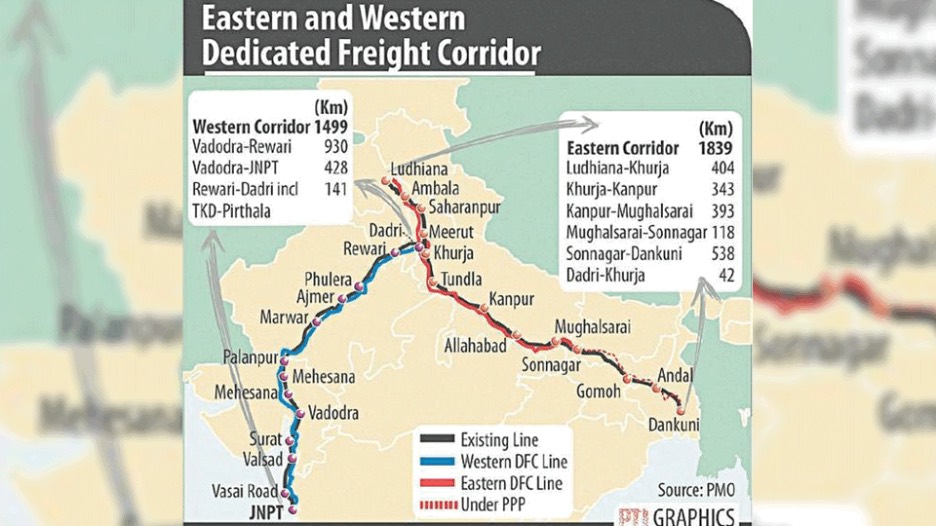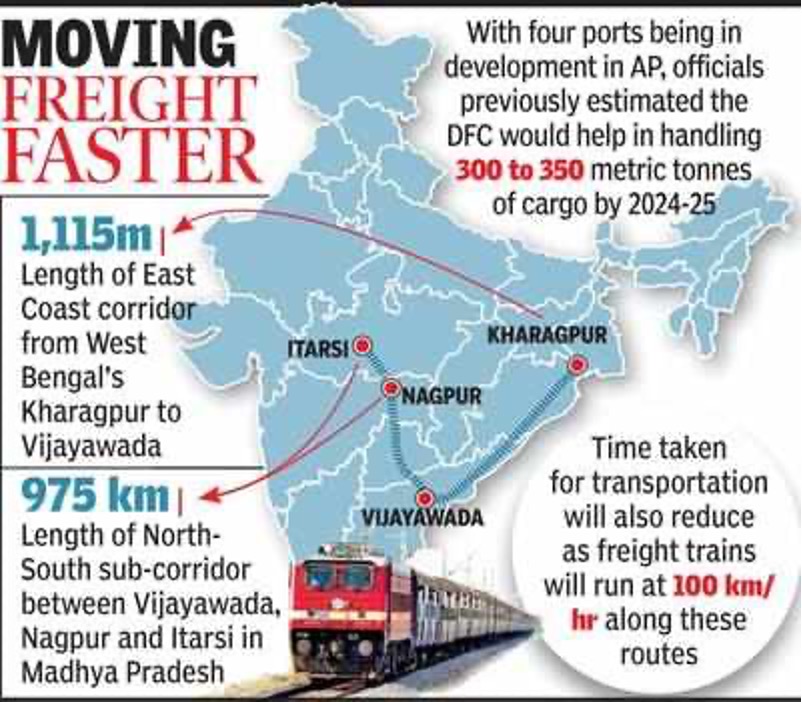History
The genesis of the Dedicated Freight Corridor (DFC) project traces back to the Tenth Plan (2002–2007), foreseeing a substantial annual growth of freight traffic by 5%. The mid-term appraisal recommended trunk routes with dedicated freight corridors to separate freight and passenger travel on high-density corridors, enhancing operational efficiency, reducing operating costs, and accommodating larger volumes of freight traffic. Consequently, the DFCs were established along the Golden Quadrilateral in April 2005.
A task force, initiated by the Committee on Infrastructure, was assigned to draft a concept paper for the Eastern Dedicated Freight Corridor (EDFC) and Western Dedicated Freight Corridor (WDFC). In July 2005, the Ministry of Railways enlisted RITES to conduct a comprehensive feasibility and preliminary engineering cum traffic survey. Recognizing the importance of technological skills, the Indian government sought assistance from Japan, which agreed in November 2005 to conduct a viability study for the DFC project.
RITES presented its feasibility report to the Union Cabinet in February 2006, obtaining in-principle approval. This led to the establishment of The Dedicated Freight Corridors Corporation of India Limited (DFCCIL) in October 2006, acting as a special-purpose entity for the construction and operation of the DFCs. JICA finalized its feasibility studies of the Western Dedicated Freight Corridor by the end of October 2007 and agreed to finance the project. Simultaneously, the Ministry of Railways approached the World Bank for financial assistance for the Eastern Dedicated Freight Corridor project. In May 2011, the World Bank approved funding for a 1,183 km section of the EDFC, linking Ludhiana and Mughalsarai.
Construction of the two long routes of the Dedicated Freight Corridor began towards the end of the Eleventh Five-Year Plan (2007-2012). These corridors cover a combined distance of 3,260 kilometers. The Eastern dedicated freight corridor spans from Ludhiana in Punjab to Dankuni in West Bengal, while the Western dedicated freight corridor originates from Jawaharlal Nehru Port in Mumbai to Dadri in Uttar Pradesh.
Upgrading transport technology, enhancing productivity, and lowering unit transport costs were the primary objectives during the Eleventh Five-Year Plan. This focus aligns with broader economic goals of higher efficiency, reduced logistics expenditures, and increased economic development through improved freight transport systems.

Economic Growth and Efficiency
The economic motivation behind the DFC is to boost the productivity of commodity transport. India has heavily relied on road transport for logistics, leading to congestion, expensive logistics, and environmental externalities. The DFC addresses these challenges by providing a dedicated rail network, significantly reducing transportation costs and time. Efficiency is a crucial step towards economic development, as it enhances the productivity of industries dependent on freight movement.
The impact of the DFC on economic growth can be categorized into two forms. Firstly, it streamlines the flow of goods, reducing transit time and costs. This efficiency is particularly crucial for time-sensitive industries and businesses dealing with perishable goods. Secondly, by alleviating congestion on highways and existing rail lines, the DFC improves overall logistical efficiency, supporting an expanded economy.
Currently, freight trains share tracks with passenger trains, resulting in a crowded network. The implementation of dedicated corridors for freight trains in the DFC will promote efficiency by ensuring quicker and more reliable shipment of goods. This involves the development of road over-bridges, road under-bridges, and rail flyovers to provide technological solutions and make the system functional.
Upon completion, the DFC is expected to transform the mode of freight transportation in India, increasing the role of rail. It is estimated to raise the average freight train speed in the corridors from 20–25 km/hr to above 60 km/hr, reducing transportation time from Mumbai to Delhi from three days to only 48 hours. This efficiency gain will help rail transport compete with roads, resulting in cost savings and lower carbon emission costs.
Experts predict that the DFC will reduce logistics costs, currently around 14% of India’s total GDP, compared to the international benchmark of 8%. The success of the project demonstrates its ability to reshape the logistics sector, expedite freight movement, and enhance economic growth in India.
Industrial Development and Regional Revitalization
India has faced historical challenges in its industrial landscape due to poor transport infrastructure and uneven industrialization across regions. The DFC, passing through areas of industrial delay, aims to act as an agent of renewal within regional parameters. The project aims to attract investments, create employment, and stimulate economic revival by establishing exclusive industrial zones with industrial development along the pipeline route.
Historical trends indicate that regions with developed transport facilities experience accelerated industrial development. The DFC, passing through regions with untapped potential, contributes to making India a manufacturing hub. It also advances the overall objective of fair industrial development among various regions, alleviating inter-regional imbalances and promoting overall economic development.
Release of Pressure on Existing Rail Lines
India’s railways have consistently faced congestion on existing rail lines, leading to unreliable and inefficient freight and passenger services. The DFC serves as a key solution to challenges threatening the quality of rail services. By decongesting existing rails and providing a dedicated corridor for freight transportation, the DFC improves the efficiency of freight services and enhances the punctuality and reliability of passenger trains.
The historical perspective recognizes the burden on India’s railway system resulting from running passenger and goods trains along the same line. These delays have led to prolonged turnaround times and poor logistical efficiencies. The separation between freight and passenger rail is a step towards eliminating these historic challenges, making the rail network more efficient.

Environmental Sustainability
The DFC’s commitment to environmentally friendly practices aligns with the global movement towards greener modes of transport. Rapid industrialization and urbanization in India have resulted in high road traffic, posing challenges of air pollution and high carbon emissions. By promoting modal shifts from road to rail, the DFC offers an environmentally friendly option for the freight transport system.
The historical context reveals an increased awareness of the environmental consequences of transport, calling for cleaner options. The DFC is shifting towards modern transport systems that use electric locomotives and contribute less to the emission of greenhouse gasses. This approach considers current demands while providing a foundation for sustainability in the planning, development, and implementation of future projects.
Innovation and Modernization
India’s path towards global economic power requires the adoption of technology and infrastructure refurbishment. This forward-looking strategy is demonstrated by the DFC, which utilizes modern technologies to improve productivity and operations. In the context of the DFC, this project is discussed in the economic language of innovation and modernization, positioning India as a technologically-focused country in the global logistics industry.
While Indian railways have undergone incremental upgrades, the magnitude and extent of the DFC venture represent an epochal transformation towards a sophisticated railway structure. Railways automation, precision-guided gantries, drones for monitoring, and advanced Operation Centers change the narrative of how railways operate in India. The economic significance of this modernization extends beyond the DFC project, shaping how India is viewed as a country that takes innovation seriously in the quest for economic development.
Socio-Economic Impact
Instead of purely focusing on monetary aspects, the immense socio-economic consequences of the Dedicated Freight Corridor (DFC) serve to drastically shape India’s social landscape. The past of our society tells us of a common trend wherein large masses migrate from farmlands to urban locales, primarily due to a larger proportion of economical options made available in city bases.
Taken into action with the aims to alleviate numerous socio-economic hurdles ranging from unemployment to regional inconsistencies in the economic field, the DFC contributes greatly not just through patch plans of jobs and assisting extensive regional advancements. It espouses a more comprehensive perspective on evolution that stretches far beyond mere financial matrices.
This perspective is validated through active recognition for the required fair growth where profits garnered from construction projects are evenly distributed within a substantial miscellany of population fragmentations. This not only addresses concerns at hand but also actualizes holistic development, revealing India’s proactive measures to serve its citizenry. It allows for a sturdy socioeconomic structure to be created while maintaining jobs across the regions on the DFC’s path; these efforts gear toward acknowledging an evenly balanced as well as viable socio-economic environmental expansion.

Challenges and Solutions
Massive infrastructure undertakings, including the DFC, are not exempt from facing their fair share of trials and tribulations. Obstructive delays, underestimated costs, and the convoluted matter of land acquisition have occupied much of the project’s journey. Drawing insights from these challenges through the lens of economics might be a viable route to comprehend them a little better.
Expenses that overshoot estimates and postponed completion timelines inflict severe blows to a project’s financial stability. That, in turn, may end up raising questions about the economic viability of the project, undermining the usability levels of the economic indices that were decided in the first place.
Moving on, the problem associated with land acquisition uncovers the complexities deriving from a tough task – Achieving a harmonious blend of economic sprint and socio-environmental mindfulness. Any conversation about these teething troubles is preferably swaddled in economic terms, drawing emphasis towards the importance of efficient project governance and the pressing need for strategies adaptive enough to counter the circumstance.
Stepping over all these barriers is crucial, not only for economic purposes alone but also for the DFC project. Corrective measures addressing the feat require an amalgamation – An unbiased curation involving proper administrative practices, harmonious liaison with interested bodies, and financial models that lean more towards commented innovations. Preferably, eyeing these from an economics spectacle should guide to sail over such events when steering mammoth-sized institutional projects towards anticipation.
Future Implications and Policy Recommendations
As the DFC nears completion, its future covers economic, social, and environmental issues. Economically, the DFC is poised to become the cornerstone of India’s exports, enhancing competitiveness and contributing to GDP growth. The social and economic impacts, through employment and community development, are consistent with the broader development objectives.
Future policy proposals will focus on sustaining the progress made by the DFC project. Constant emphasis on private sector involvement through public-private partnerships (PPPs) ensures the sustainability and viability of the project. The economic discourse surrounding policy proposals emphasizes the importance of creating an enabling environment for private investment, simplifying regulatory frameworks, and ensuring a transparent and accountable governance structure. Skills development will prove to be a key factor in accentuating the socio-economic impact of DFC. A collaborative effort between the government, industry stakeholders, and educational institutions can ensure that communities have the necessary skills to participate in and benefit from the economic opportunities created by DFC.
Conclusion
In conclusion, India’s dedicated freight corridors represent a combination of economic necessity, operations, historical challenges, and forward-looking approaches. The economic discourse surrounding the DFC project emphasizes its role as a catalyst for economic growth, technological progress, and environmental sustainability. As the project nears completion, it stands as a testament to India’s ability to develop transformative infrastructure to meet complex challenges and adapt to global trends in a sustainable manner. The DFC’s economic significance extends beyond its immediate impact, influencing policy discourse and shaping the trajectory of India’s logistics sector in the years to come.
Written by – Annesha Sengupta
Edited by – Kushi Mayur
